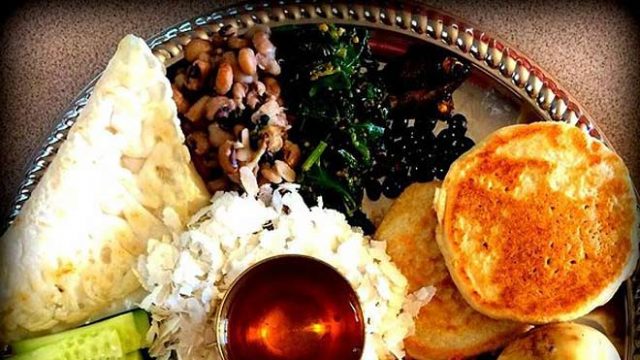The Newars of Kathmandu valley have graced Nepal with resplendent architecture, lost-wax and repousse metalwork, lattice windows—and with such marvels as mamacha, a spicy, delectable version of Tibetan momo dumplings. For their culinary inventions, the rest of the country is especially grateful. Doomed to complacency in the kitchen, Nepal’s non-Newars–97 percent of the population–have made do, throughout history, with two meals of daal-bhaat a day, or dhindo (cooked flour paste), kholay (flour broth), and wheat/corn/millet roti. Mercifully, those who live in Kathmandu can now raid kabab kitchens, slurp thukpa at noodle stands, down an odd pasta or sweet-and-sour or satay, and flock to Newari food joints.
Now I am a vegetarian, but a bad one: I have developed an unfortunate fondness for fried goat lungs. (It all began with not being able to give up sushi, which led to a few plates of mamacha a year, which led to graver transgressions). About once a year, I indulge my inner carnivore by feasting on extremely meaty meats, preferably prepared by Newari hands.
A cardinal truth about Newari food joints: the cheaper the bill, the better the food. High-end Newari restaurants can bewilder customers with their bland offerings and translated menus–“indigenous pizza”, “fried molasses”. By contrast, shops called “the place behind Krishna Mandir” or “Jagate’s shop” attract hoards of loyal customers.
Harati, just off the tourist district Thamel, is Kathmandu’s Newari restaurant of the moment. It consists of a ground-floor room done up, perfunctorily, with tables and chairs. By sundown it is packed with men, most of them from the high Bahun and Chettri castes, all of them bent on shaming their ancestors by consuming forbidden flesh and spirits. Bottles of Everest whisky and Khukuri rum gleam in a showcase to one side.
The restaurant’s proprietor, Ram Krishna Maharjan, is a marathon runner given to such madness as dashing from Kathmandu to the base of the himals and back. He also flits nimbly from table to table. “Newari food is the only Nepali cuisine that can beat Indian food for taste,” he says to us. “Of course we have to convince people about some dishes. Sometimes we modify some items. We ourselves have no qualms about our food, but its appearance can put others off.” As though to prove his point, his wife brings over two clay pots, one containing sanya khuna, an amber-colored fish gelatin with a brick red topping and a sour fish taste, and the other containing ta khala, a gelatin of skin and bones, which looks and tastes like lard. Both these dishes are prized at Newari feasts, we are told.
We settle for less adventurous fare. First we work through tuccha, a plate full of baji (beaten rice), chhoela (spiced burned meat), bhatmas (peas) and alooko achar (potatoes pickled in sesame). The plate includes a translucent maroon dish, kachila, or spiced raw meat. We move onto chatamari, a thin rice roti topped with ground meat and eggs, and an excellent, piping hot gravy of potato, beans and bamboo shoot, calledchhwon. Now we are ready to begin on the real task of the evening, which is to ingest a variety of buffalo dishes.
Our first buffalo dish is mye puka, or tongue, which is surprisingly tender, and of a dark, burned color and rich flavor. After this we eat khaago, lightly fried stomach bits that are crisp at the edges but soft inside, and tisya, cylindrical bits of spinal cord fluid that are fluffy and liquid all at once. Nhyafu, or brain, is more watery—it melts in the mouth. All these dishes are only lightly spiced. “First we wash the meat and boil it in turmeric water,” the proprietor says, “then we fry it with salt and pepper. We’re very meticulous about hygiene.”
This is good to hear, because our next dish is safu micha, bone marrow of buffalo wrapped in a thick, layered part of the stomach euphemistically called sayapatri, or marigold. Safu micha looks like a charred rubber ball with goose bumps. When you put it in your mouth, the crunchy lining bursts and warm, salty bone marrow pours out. That pleasure is as much textural as it is taste-related; but eating safu micha leads to a heavy, cholesterol-laden sensation in the chest, and a sober sense that perhaps enough is enough.
And so we round off our meal with a few fluffy baaraa of maas daal, a cauliflower dish, and a chutney of sesame, tomato and lapsi (hog plum). All this we wash down with liberal amounts of aila, home-brewed rice and millet liquor. Then we sit back, dazed, and contemplate the buffalo. A beast so mud-caked, so dry-skinned, so—unappetizing to behold: what inventiveness to transform it into mouth-watering victuals. What imagination, what refinement! My inner carnivore gurgles in satiation.




